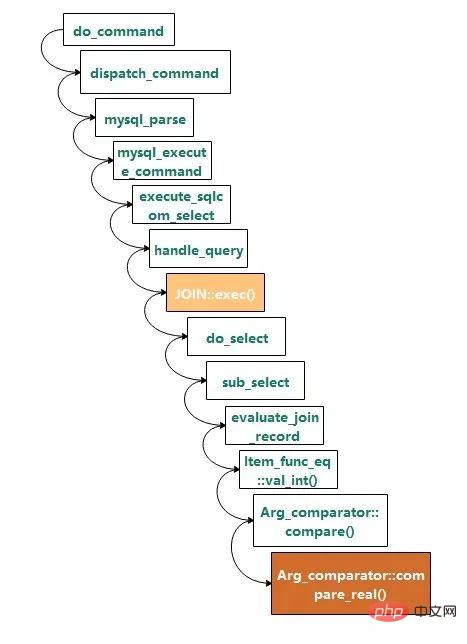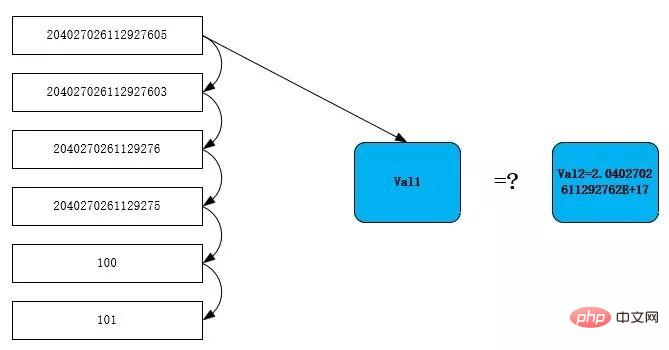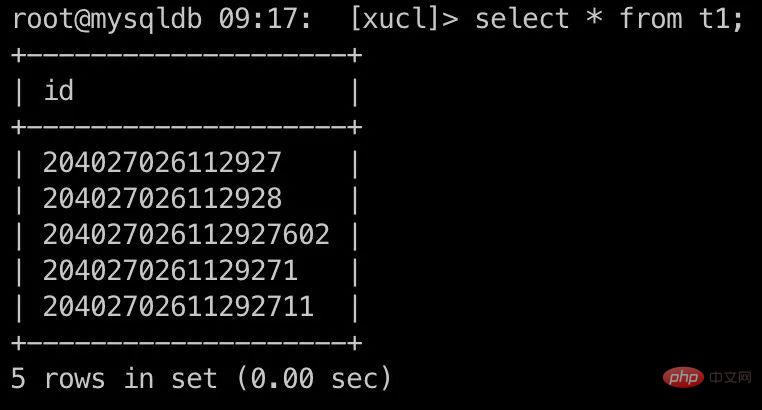Maison >base de données >tutoriel mysql >Jetez un œil aux incroyables conversions implicites de MySQL
Jetez un œil aux incroyables conversions implicites de MySQL
- coldplay.xixiavant
- 2021-01-13 09:20:412114parcourir
La colonne du didacticiel MySQL présente les conversions implicites associées

Autres apprentissages gratuits connexes Recommandé : Tutoriel mysql(vidéo)
1. Description du problème
root@mysqldb 22:12: [xucl]> show create table t1\G
*************************** 1. row ***************************
Table: t1
Create Table: CREATE TABLE `t1` (
`id` varchar(255) DEFAULT NULL
) ENGINE=InnoDB DEFAULT CHARSET=utf8
1 row in set (0.00 sec)
root@mysqldb 22:19: [xucl]> select * from t1;
+--------------------+
| id |
+--------------------+
| 204027026112927605 |
| 204027026112927603 |
| 2040270261129276 |
| 2040270261129275 |
| 100 |
| 101 |
+--------------------+
6 rows in set (0.00 sec)Phénomène étrange :
root@mysqldb 22:19: [xucl]> select * from t1 where id=204027026112927603; +--------------------+ | id | +--------------------+ | 204027026112927605 | | 204027026112927603 | +--------------------+ 2 rows in set (0.00 sec)

Bon sang, le chèque est évidemment 204027026112927603, pourquoi 204027026112927605 est également sorti
2. Explication du code source
La relation d'appel de pile est la suivante :

où JOIN::exec() est le point d'entrée pour l'exécution , Arg_comparator::compare_real() est une fonction de jugement d'équivalence, qui est définie comme suit
int Arg_comparator::compare_real()
{
/*
Fix yet another manifestation of Bug#2338. 'Volatile' will instruct
gcc to flush double values out of 80-bit Intel FPU registers before
performing the comparison.
*/
volatile double val1, val2;
val1= (*a)->val_real();
if (!(*a)->null_value)
{
val2= (*b)->val_real();
if (!(*b)->null_value)
{
if (set_null)
owner->null_value= 0;
if (val1 < val2) return -1;
if (val1 == val2) return 0;
return 1;
}
}
if (set_null)
owner->null_value= 1;
return -1;
}Les étapes de comparaison sont présentées dans la figure ci-dessous. Lisez la colonne id de la table t1 ligne par ligne et placez-la dans val1. , et la constante 204027026112927603 existe dans le cache, tapez Elle est de type double (2.0402702611292762E+17), donc après avoir passé la valeur à val2 ici, val2=2.0402702611292762E+17.

Lorsque la première ligne est numérisée, la valeur de 204027026112927605 convertie en doule est 2.0402702611292762e17. L'équation est établie et la ligne est déterminée pour remplir les conditions. down. La raison 204027026112927603 est également cohérente avec

Comment détecter si le numéro de type chaîne converti en type double déborde ?Après avoir testé ici, lorsque le nombre dépasse 16 chiffres. , il est converti en Le type double est déjà inexact , par exemple, 20402702611292711 sera exprimé comme 20402702611292712 (val1 dans l'image)


Conversion de chaîne MySQL La définition de la fonction en double est la suivante :
{
char buf[DTOA_BUFF_SIZE];
double res;
DBUG_ASSERT(end != NULL && ((str != NULL && *end != NULL) ||
(str == NULL && *end == NULL)) &&
error != NULL);
res= my_strtod_int(str, end, error, buf, sizeof(buf));
return (*error == 0) ? res : (res < 0 ? -DBL_MAX : DBL_MAX);
}La vraie fonction de conversion my_strtod_int se trouve dans dtoa.c (c'est trop compliqué, il suffit de poster un commentaire)
/*
strtod for IEEE--arithmetic machines.
This strtod returns a nearest machine number to the input decimal
string (or sets errno to EOVERFLOW). Ties are broken by the IEEE round-even
rule.
Inspired loosely by William D. Clinger's paper "How to Read Floating
Point Numbers Accurately" [Proc. ACM SIGPLAN '90, pp. 92-101].
Modifications:
1. We only require IEEE (not IEEE double-extended).
2. We get by with floating-point arithmetic in a case that
Clinger missed -- when we're computing d * 10^n
for a small integer d and the integer n is not too
much larger than 22 (the maximum integer k for which
we can represent 10^k exactly), we may be able to
compute (d*10^k) * 10^(e-k) with just one roundoff.
3. Rather than a bit-at-a-time adjustment of the binary
result in the hard case, we use floating-point
arithmetic to determine the adjustment to within
one bit; only in really hard cases do we need to
compute a second residual.
4. Because of 3., we don't need a large table of powers of 10
for ten-to-e (just some small tables, e.g. of 10^k
for 0 <= k <= 22).
*/Dans ce cas, Le résultat du cas sans débordement dans notre test
root@mysqldb 23:30: [xucl]> select * from t1 where id=2040270261129276; +------------------+ | id | +------------------+ | 2040270261129276 | +------------------+ 1 row in set (0.00 sec) root@mysqldb 23:30: [xucl]> select * from t1 where id=101; +------+ | id | +------+ | 101 | +------+ 1 row in set (0.00 sec)
est conforme aux attentes, et dans ce cas, l'écriture correcte devrait être
root@mysqldb 22:19: [xucl]> select * from t1 where id='204027026112927603'; +--------------------+ | id | +--------------------+ | 204027026112927603 | +--------------------+ 1 row in set (0.01 sec)
3. Conclusion
Évitez la conversion de type implicite. Les types de conversion implicite incluent principalement des types de champs incohérents, dans des paramètres contenant plusieurs types, des types de jeux de caractères incohérents. ou des règles de classement, etc.
La conversion de type implicite peut entraîner l'impossibilité d'utiliser les index, des résultats de requête inexacts, etc., vous devez donc sélectionner soigneusement
Il est recommandé que le type numérique soit défini comme int ou bigint lors de la définition du champ. Lorsque la table est associée, les champs associés doivent conserver le. mêmes types, jeux de caractères et règles de classement
-
Enfin, veuillez publier les instructions sur la conversion de type implicite à partir du site officiel
1、If one or both arguments are NULL, the result of the comparison is NULL, except for the NULL-safe <=> equality comparison operator. For NULL <=> NULL, the result is true. No conversion is needed. 2、If both arguments in a comparison operation are strings, they are compared as strings. 3、If both arguments are integers, they are compared as integers. 4、Hexadecimal values are treated as binary strings if not compared to a number. 5、If one of the arguments is a TIMESTAMP or DATETIME column and the other argument is a constant, the constant is converted to a timestamp before the comparison is performed. This is done to be more ODBC-friendly. This is not done for the arguments to IN(). To be safe, always use complete datetime, date, or time strings when doing comparisons. For example, to achieve best results when using BETWEEN with date or time values, use CAST() to explicitly convert the values to the desired data type. A single-row subquery from a table or tables is not considered a constant. For example, if a subquery returns an integer to be compared to a DATETIME value, the comparison is done as two integers. The integer is not converted to a temporal value. To compare the operands as DATETIME values, use CAST() to explicitly convert the subquery value to DATETIME. 6、If one of the arguments is a decimal value, comparison depends on the other argument. The arguments are compared as decimal values if the other argument is a decimal or integer value, or as floating-point values if the other argument is a floating-point value. 7、In all other cases, the arguments are compared as floating-point (real) numbers.
Ce qui précède est le contenu détaillé de. pour plus d'informations, suivez d'autres articles connexes sur le site Web de PHP en chinois!
Articles Liés
Voir plus- Comment tester si la connexion à la base de données réussit dans MySQL
- La requête lente de MySQL a-t-elle un impact ?
- Explication détaillée de l'optimisation MySQL 5.7 : Expliquer le plan d'exécution
- Comment définir un champ d'incrémentation automatique dans une table existante dans MySQL
- Chat Gestion de la mémoire MySQL, allocateur de mémoire et systèmes d'exploitation
- PHP exploite la base de données MySQL pour interroger les données et les afficher sur la page Web

